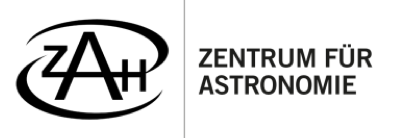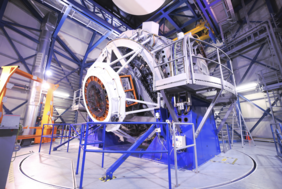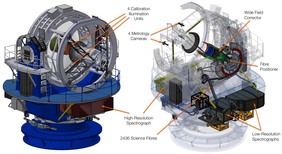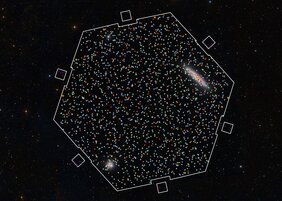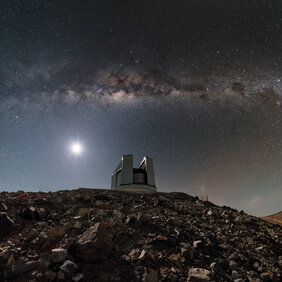4MOST: the largest multi-object spectroscopic survey telescope in the southern hemisphere captures "First Light"
On October 18, 2025, the 4-metre Multi-Object Spectroscopic Telescope (4MOST) facility, installed on the VISTA telescope at the European Southern Observatory’s (ESO) Paranal Observatory in Chile's Atacama Desert, obtained its first light. This milestone marks the moment it is ready to begin its scientific journey. In the course of 15 years, 4MOST will provide detailed information on tens of millions of stars and galaxies. The instrument has been constructed by a consortium including a team of scientists and engineers of the Landessternwarte, which is part of the Centre for Astronomy of Heidelberg University (ZAH).
4MOST is the largest multi-object spectroscopic survey facility in the southern hemisphere mounted on the 4-m-class telescope VISTA at ESO's Paranal Observatory operational environment. It is unique in its combination of a large field of view, the number of simultaneous observed objects, and the number of spectral colours simultaneously registered. 4MOST can simultaneously unravel the light of 2,400 celestial objects into 18,000 spectral colour components, allowing astronomers to study their detailed chemical composition and properties.
Once fully operational, 4MOST will investigate the formation and evolution processes of stars and planets, the Milky Way and other galaxies, black holes and other exotic objects, and of the Universe as a whole. By analysing the detailed spectra of thousands of objects every 10–20 minutes, 4MOST will build a catalogue of temperatures, chemical compositions, velocities and many more physical parameters of tens of millions of objects spread across the entire Southern sky. Development started in 2010 and the facility has been designed to now operate for at least the next 15 years.
Heidelberg contributions
The 4MOST facility is designed, built, and scientifically operated by a Consortium of 30 universities and research institutes in Europe and Australia under leadership of the Leibniz Institute for Astrophysics Potsdam (AIP).
4MOST features a 2.5-degree diameter field-of-view on the sky (about five times the apparent diameter of the moon) with 2436 science fibres in the focal plane. The fibres will be configured by a fibre positioner and feed the light of astronomical objects into three spectrographs: two low-resolution spectrographs (LRS) and one high-resolution spectrograph (HRS).
The development, design and manufacture of the HRS has been in hands of the Landessternwarte as one of the main institutes involved in the development and building of important technical components of this newest working horse of modern astronomy.
"The fact that we can now start the science operations with 4MOST is the culmination of more than 15 years of development and construction within the 4MOST consortium," said Prof. Dr. Andreas Quirrenbach, director of Landessternwarte/ZAH and head of the local 4MOST team. "The quantity and quality of the data we have already seen after the recent first light observations is truly breathtaking. There is no question that 4MOST will achieve extraordinary things in the exploration of the Milky Way and other objects in the universe," Quirrenbach adds.
The 4MOST High-Resolution Spectrograph (HRS), which is one of the central devices of this facility, records high-resolution spectra simultaneously for 812 objects, across three fixed wavelength ranges (393–436 nm, 516–573 nm, 610–679 nm).
Prof. Dr. Norbert Christlieb, deputy director of the Landessternwarte, and principal investigator of one of the 18 science projects that will be carried out with 4MOST, explains that "allowing the clean separation of narrow stellar absorption lines via the HRS is essential to deliver precise radial velocities - which the instrument will measure with an accuracy of less than 1 km per second - and detailed chemical abundances for stars in the Milky Way. The HRS also serves as Gaia follow-up for the fine-grained work like chemical tagging, which is an astrophysical technique that uses a star's chemical composition to trace its origin or grouping stars with similar abundances that likely formed in the same stellar cluster or molecular cloud to reconstruct the Galaxy’s formation and evolution, " the Heidelberg expert on galactic archeology says.
The excellent performance of the 4MOST HRS is a success of the LSW instrument team under lead of Dr. Walter Seifert and its outstanding experience in developing and manufacturing high class astronomy instrumentation. "That we now have reached first light is the major and most exciting milestone for the project in general after many years of hardware development or working with simulated data," he said.
But complex hardware requires equally complex software to control the instruments' setup, its performance and data output. This part was taken over by the LSW software group under lead of Dr. Florian Rothmaier. Rothmaier and his team has been responsible for developing the instrument control software for the 4MOST project, which is used to carry out all observations and calibration sequences. The software controls the connected hardware (cameras, shutters, lamps, motors, etc.), interacts with the VISTA telescope software and generates the data products that are fed into the ESO data archive and thus into the data pipeline.
The Landessternwarte and its team will continue to support 4MOST and, if necessary, provide technical upgrades in the coming years, thus ensuring its scientific success.
ADDITIONAL INFORMATION
About the First Light observations
The First Light observations exemplify the unique capabilities of 4MOST: its ability to observe a very large field of view and its capability to investigate a large number of very different objects and science cases simultaneously in great detail. For these first light observations a dedicated area on the southern sky had been selected with a couple of interesting and diverse astronomical objects.
One of the objects dominating the First Light observation of 4MOST is the elongated galaxy NGC253, also called the Sculptor or Silver Coin galaxy. Except for the Magellanic Clouds, it is the galaxy with the largest apparent diameter in the southern sky with nearly the same diameter as the moon, only much fainter. It is known to currently form a lot of new stars. The 4MOST observations also capture a super star cluster, various hot and cold stars and their movements, and gas glowing from newly formed stars in this galaxy.
The other large object seen in the field is the Globular Cluster NGC288, a very dense group of about 100,000 very old stars in the outskirts of the Milky Way. It formed about 13.5 billion years ago in the very earliest phases of the formation of the Milky Way. Its stars contain very small amounts of chemical elements heavier than hydrogen and helium, reflecting it’s pristine composition.
In addition to these two very large objects, 4MOST obtained spectra of more than two thousand other objects in its first science observation. These include spectra of a large variety of bright and faint stars in our Milky Way, allowing scientists to determine their temperature, mass, diameter, velocity, age and evolutionary stage, and chemical composition. Beyond the Milky Way, spectra of a pair of overlapping galaxies at 900 million lightyears were obtained, as well as spectra of more than a thousand other galaxies near and far to determine their distance, star formation history or the mass of their central black hole.
Users, Surveys, Science
The 4MOST science team consists of more than 700 investigators from universities and research institutes around the world. In its first five years of operations, 4MOST will conduct 25 different science programmes, ten designed by institute members of the consortium that built the instrument, whereas the other fifteen programmes were selected by an external committee of astronomers. Uniquely, the multi-fibre nature of 4MOST enables many science programmes to be observed simultaneously. For example, a few fibres can be used to study rare objects, while at the same time another program can use most other fibres to make large statistical samples of stars or galaxies.
Highlighted 4MOST science cases are the origin of the chemical elements and the formation of the first stars, the growth of the Milky Way over cosmic time, the formation and evolution of galaxies and black holes, the make-up of the unseen Dark Matter that seems to encompasses most of the mass in galaxies, and the nature of Dark Energy that drives the accelerating expansion of the Universe.
About the facility
At the heart of the system, 4MOST uses 2438 optical fibres, each the size of a human hair, to catch the light of celestial objects. Light from each of these fibres is transported to the spectrographs that break up the light in its different colours.
A large, new, nearly 1m-diameter optical camera lens system was installed in the VISTA telescope of the European Southern Observatory (ESO) in Chile to give 4MOST a field of view on the sky of 2.5 degrees diameter, five times larger than the diameter of the moon and one of the largest in the world for a 4m-class telescope.
4MOST will observe a new set of objects in the sky every 10–20 minutes using a fibre positioner that moves all fibres to observe new objects in less than 2 minutes. The fibres transport the light to three spectrographs that each observe 800 objects simultaneously, where their light is first broken up in red, green, and blue components and then in further detail to then be registered by large 36 Megapixels detectors.
There are two spectrographs that cover the entire colour spectrum from the very blue all the way into the infrared (370–950 nm), whereas the third high-resolution spectrograph (see Heidelberg contribution) looks at higher wavelength resolution in three selected colour bands to better measure chemical element abundances in stars.
Operations
Planning of 4MOST observations is done remotely from the Max Planck Institute for Extraterrestrial Physics (MPE) in Garching near Munich. A few minutes before the next observation needs to start a next field and new objects are optimally selected based on the latest weather and observing conditions information.
Executing the observations and maintaining the instrument is the responsibility of the European Southern Observatory (ESO). The data obtained are transferred to the 4MOST data centre at the University of Cambridge, where they are analysed with an extensive set of software pipelines to extract physical parameters of the studied objects.
The analysis results are then transferred to data archives at the Leibniz Institute for Astrophysics Potsdam (AIP) and ESO to be distributed to all project members and to the entire scientific community for scientific exploration.
Consortium and Construction
The 4MOST facility is designed, built, and scientifically operated by a Consortium of 30 universities and research institutes in Europe and Australia under leadership of the Leibniz Institute for Astrophysics Potsdam (AIP). The main institutes involved in building and operating of the facility are:
- Leibniz Institute for Astrophysics Potsdam (AIP): consortium lead, telescope corrector and guiding system, metrology, control software, fibre system, and archive system,
- Macquarie University / Australian Astronomical Optics (AAO): fibre positioner,
- Centre de Recherche Astrophysique de Lyon (CRAL): low-resolution spectrographs,
- European Southern Observatory (ESO): detector systems
- Max Planck Institute for Astronomy (MPIA): instrument control hardware
- Max Planck Institute for Extraterrestrial Physics (MPE): observation planning and remote operations,
- Nederlandse Onderzoekschool Voor Astronomie (NOVA): calibration system,
- University of Cambridge, Institute of Astronomy (IoA): data management,
- Universität Hamburg (UHH), Hamburger Sternwarte: archive and user management,
- Universität Heidelberg, Zentrum für Astronomie (ZAH), Landessternwarte: high-resolution spectrograph and instrument control software.
All these institutes are also involved in the scientific analysis and exploration, as are the following major consortium partners: Durham University, Department of Physics, École polytechnique fédérale de Lausanne, Lunds universitet, , Rijksuniversiteit Groningen, University of Bath, University of Western Australia, Uppsala unversitet, and minor consortium participants: Georg-August-Universität Göttingen, L'Observatoire de Paris, Laboratoire des Matériaux Avancés, Max-Planck-Institut für Radioastronomie, University College London, Universität Potsdam, University of Sussex, University of Tartu, University of Warwick, Lancaster University, University of Portsmouth, University of Southampton, and Queen’s University Belfast.
FURTHER LINKS AND MEDIA
Homepage of the 4MOST Consortium
Press Release and Media Kit (Videos & Images) of the Leibnitz-Institut für Astrophysik Potsdam (AIP)
ESO Press Release
Centre for Astronomy of Heidelberg University (ZAH)
SCIENTIFIC CONTACTS AT THE LANDESSTERNWARTE
Prof. Dr. Andreas Quirrenbach
a.quirrenbach@lsw.uni-heidelberg.de
Prof. Dr. Norbert Christlieb
n.christlieb@lsw.uni-heidelberg.de
Dr. Walter Seifert
wseifert@lsw.uni-heidelberg.de
Dr. Florian Rothmaier
frothmaier@lsw.uni-heidelberg.de
CONTACT FOR MEDIA INQUIRIES
Dr. Guido Thimm
Centre for Astronomy of Heidelberg University (ZAH)
thimm@uni-heidelberg.de
